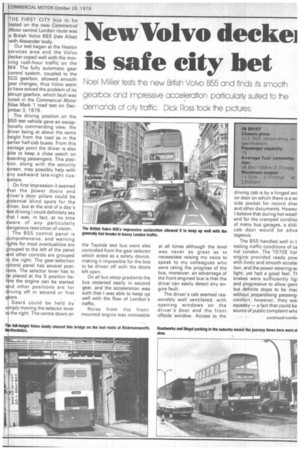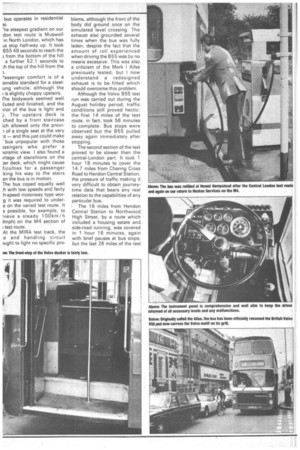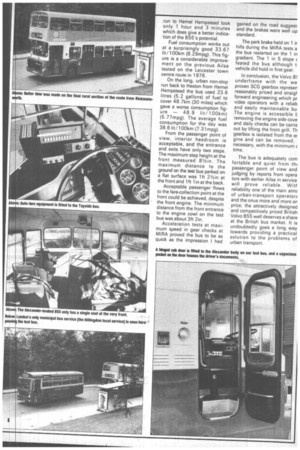New Volvo deekei
Page 67

Page 68

Page 69

If you've noticed an error in this article please click here to report it so we can fix it.
iss fe city bet Noel Millier tests .--)e new British Volvo B55 and finds its smoo gearbox anc impressive acceleration particularly suited to demanc s of city traffic. Dick Ross took e pictures.
THE FIRST CITY bus to be tested on the new Commercial Motor central London route was a British Volvo B55 (née Ailsa) with Alexander body.
Our test began at the Heston services area and the Volvo
ecker coped well with the morning rush-hour traffic on the M4. The fully automatic gear control system, coupled to the SCG gearbox, allowed smooth gear changes; thus Volvo seem. to have solved the problem of its
brupt gearbox, which fault was oted in the Commercial Motor ilsa Mark 1 road test on Dec mber 3, 1976.
The driving position on the 55 test vehicle gave an exceptionally commanding view, the driver being at about the same height from the road as in the earlier half-cab buses. From this vantage point the driver is also able to keep a close watch on boarding passengers. This position, along with the security Screen, may possibly help with any awkward late-night customers.
On first impression it seemed that the power doors and driver's door pillars could be potential blind spots for the driver, but at the end of a day's test driving I could definitely say that I was, in fact, at no time aware of any particularly dangerous restriction of vision.
The B55 control panel is comprehensive, and warning lights for most eventualities are rouped to the left of the panel and other controls are grouped t the right. The gear-selection ntrol panel has several posit ons. The selector lever has to e placed at the S position bef re the engine can be started and other positions are for driving off in second or first ars.
Gears could be held by s mply moving the selector lever ti the right. The centre doors on the Tayside test bus were also controlled from the gear selector which acted as a safety device, making it impossible for the bus to be driven off with the doors left open.
On all but steep gradients the bus restarted easily in second gear, and the acceleration was such that I was able to keep up well with the flow of London's traffic.
Noise from the frontmounted engine was noticeable at all times although the level was never so great as to necessitate raising my voice to speak to my colleagues who were rating the progress of the bus, moreover, an advantage of the front-engined bus is that the driver can easily detect any engine fault.
The driver's cab seemed reasonably well ventilated, with opening windows on the driver's door and the front offside window. Access to the driving cab is by a hinged ext ior door on which there is a wi side pocket for record she and other documents. Howev I believe that during hot weatf and for the cramped conditio of many bus garages, a slidi cab door would be adva tageous.
The B55 handled well in t testing traffic conditions of cc tral London. The TD7OE Vol engine provided ready pow with lively and smooth acceler tion, and the power steering wi light, yet had a good feel. -1-1' brakes were sufficiently ligl and progressive to allow gent but definite stops to be mac without jeopardising passengi comfort; however, they wei squeaky — a fact that could be source of public complaint whe
bus operates in residential
3S.
he steepest gradient on our don test route is Muswell in North London, which has as stop half-way up. It took B55 48 seconds to reach the ) from the bottom of the hill: a further 52.1 seconds to 3h the top of the hill from the ).
'assenger comfort is of a ionable standard for a steelung vehicle, although the is slightly choppy upstairs. ihe bodywork seemed well 'cuted and finished, and the irior of the bus is light and
. The upstairs deck is ched by a front staircase ich allowed only the provi: of a single seat at the very — and this just could make bus unpopular with those ;sengers who prefer a loramic view. I also found a )rtage of stanchions on the )er deck, which might cause ficulties for a passenger king his way to the stairs en the bus is in motion.
The bus coped equally well :h with low speeds and fairly h-speed motorway type worg it was required to undere on the varied test route. It s possible, for example, to iieve a steady 100km*/ h )mph) on the M4 section of test route.
At the MIRA test track, the e and handling circuit )ught to light no specific pro blems, although the front of the body did ground once on the simulated level crossing. The exhaust also grounded several times when the bus was fully laden, despite the fact that the amount of roll experienced when driving the B55 was by no means excessive. This was also a criticism of the Mark I Ailsa previously tested, but I now understand a redesigned exhaust is to be fitted which should overcome this problem.
Although the Volvo 855 test run was carried out during the August holiday period, traffic conditions still proved hectic: the first 14 miles of the test route, in fact, took 56 minutes to complete. Bus stops were observed but the B55 pulled away again immediately after stopping.
The second section of the test proved to be slower than the central-London part. It took 1 hour 18 minutes to cover the 14.7 miles from Charing Cross Road to Hendon Central Station, the pressure of traffic making it very difficult to obtain journey-1 time data that bears any real relation to the capabilities of any particular bus.
The 16 miles from Hendon Central Station to Northwood High Street, by a route which included a housing estate and. side-road running, was covered in 1 hour 16 minutes, again with brief pauses at bus stops; but the last 26 miles of the test .run to Hemel Hempstead took only 1 hour and 3 minutes which does give a better indication of the B55's potential.
Fuel consumption works out at a surprisingly good 33.67 lit/100km (8.29mpg). This figure is a considerable improvement on the previous Ailsa tested on the Leicester town centre route in 1976.
On the long, urban non-stop run back to Heston from Hemel Hempstead the bus used 23.6 litres (5.2 gallons) of fuel to cover 48.7km (30 miles) which gave a worse consumption figure — 48.9 lit/100km) (5.77mpg). The average fuel consumption for the day was 38.6 lit/100km (7.31mpg).
From the passenger point of view, interior headroom is acceptable, and the entrance and exits have only two steps. The maximum step height at the front measured 81/2in. The maximum distance to the ground on the test bus parked on a flat surface was 1 ft 21/2in at the front and 1ft lin at the back.
Acceptable passenger flows to the fare-collection point at the front could be achieved, despite the front engine. The minimum distance from the front entrance to the engine cowl on the test bus was about 3ft 2in.
Acceleration tests at maximum speed in gear checks at MIRA proved the bus to be as quick as the impression I had
gained on the road suggest, and the brakes were well up standard.
The park brake held on 1 ir hills during the MIRA tests a the bus restarted on the 1 in gradient. The 1 in 5 slope c feated the bus although t vehicle did hold in first gear.
In conclusion, the Volvo BI underframe with the we proven SCG gearbox represen reasonably priced and straigh forward engineering which pr vides operators with a reliab and easily maintainable bu The engine is accessible t removing the engine side cove and daily checks can be carrie out by lifting the front grill. Th gearbox is isolated from the er gine and can be removed, necessary, with the minimum c time.
The bus is adequately com fortable and quiet from tht passenger point of view and judging by reports from opera tors with earlier AiIse in service will prove reliable. With reliability one of the main aim: of urban-transport operators and the onus more and more on price, the attractively designed and competitively priced British Volvo B55 well deserves a share at the British bus market. It is undoubtedly goes a long way towards providing a practical solution to the problems of urban transport.
























































































































